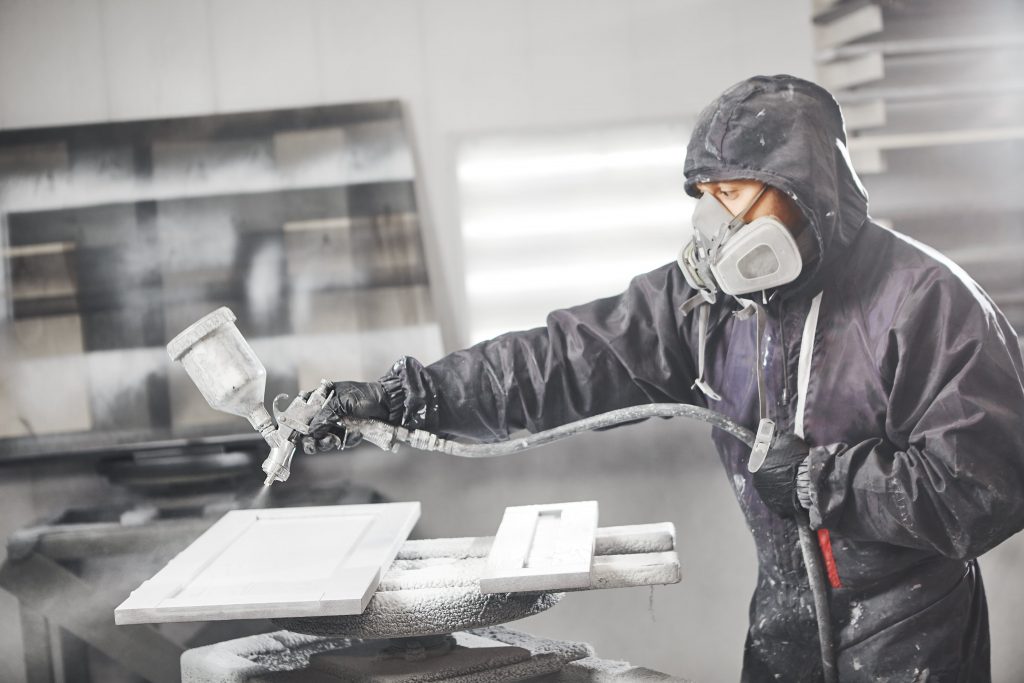Every paint project needs a smooth finishing look, which is really done by spray paint! No matter how many times you use spray paint, you will definitely wonder about the flammability of this paint! Now, the question really comes to your mind, “Is spray paint flammable?”
The answer will be yes! Let’s make it easy. Spray paint is flammable! The substance presence on this paint makes the fumes ignite. Basically, spray paint contains propellants such as butane or propane, which are highly flammable. While using spray paint, if flame catches it, fire can ignite easily.
In this article, we’ll discuss more about the causes and safety precautions for the flammability of spray paint. To know the depth, keep reading thIs article.

Navigation
Is paint flammable – A comprehensive Guide?
Paint is a necessary item that can be flammable too. But, all paints are not flammable. Actually, the main cause of flammability is what types of ingredients (such as solvent, pigment, binder) are used in the paint liquids.
In general, these substances of paints are used for better quality, texture, color, and so on.
That’s why first you have to know which paints contain flammable liquids or which are not!
Here, different types of paint are discussed to know which are flammable. Take a look at the below-
- Is Water-Based Paint Flammable?
Water-based paints are most widely used in present times in houses, offices, or other workplaces. It is environment-friendly and also not flammable. The binder of the liquid paint is only the reason why it’s non-flammable.
The binder of the water-based paints forms of water. As a result, if there’s any flammable material near, it’ll never cause fire or explode as it carries water.
Simply, liquid-based paint such as acrylic and latex paint is non-flammable. But, some water-based paint can be flammable too.
- Is Oil-Based Paint Flammable?
Oil-based paints are more flammable than other paints. Generally, it contains components such as toluene, methanol, and ketones which are highly flammable.
After prolonged use, it can form gasses of volatile organic compounds, quickly catching fires. Otherwise, when the oil-based paints are fully dry, there’s no safety risk at all.
- Is spray paint flammable?
Spray paint is highly flammable. The propellant such as butane or propane gas present in the spray paint could cause flammability.
These gases push the paint from the can to spray out. Here, another cause can be the highly pressurized can of spray paint.
The spray paint can be more dangerous if it gets damaged. There’s the possibility of getting fire and the flashback of spray that could instigate hazardous explosions.
So, the storage of spray paint needs to be very careful. Having flammable material nearby is the sure possibility of getting a big fire or an explosion.
In the below, we’ll discuss more about the safety precautions and storage tips of spray paint. So, don’t miss it!
Is spray paint flammable when dry?
Basically, every paint is non-toxic and safe after drying. But, In the same cases when you’re curious about spray paint, you’ve to learn about two different terms. These are: Flammable and combustible.
Although flammable and combustible terms are considered the same, but there are a few differences between them.
Combustible usually means that something will burn. Again, the term flammable carries the meaning of burning ability with faster speed and much more violently.
Before drying, spray paint is highly flammable. But after it dries, spray paint is only combustible, not flammable!
Again, if we want to get the exact cause, then it needs a short discussion. Like, when spraying paint in its original container, there’s a solvent present in the paint that makes it flammable.
When it is applied or becomes dried, the solvent evaporates. That’s why spray paint then gets only combustible, not flammable.
How long are spray paint fumes flammable?
Naturally, the flammable liquid of the paint doesn’t burn. The mixture of fumes and present air is the main source which causes burn or explosion.
The interesting matter is when you’re afraid of spray paint fumes flammability! Spray paint fumes can ignite easily. But how long does it last?
Generally, it mostly takes 2-4 days to get your new painted room fumes-free. But this also depends on some factors such as-
- Room size
- Paint types
- Ventilation types
To avoid the risk of fumes getting flammable, you need to follow some instructions carefully –
- First, read all the safety instructions and warnings which are attached to the label of the paints.
- Notice every tool, whether they contain any combustible substance or not.
- Never use any fire or heat substance while using spray paint on your house.
- Store the flammable paints in a dry place.
- Maintain your spray paint carefully. Don’t damage or puncture it.
Is Rust-Oleum Spray Paint Flammable?
Rust-oleum spray paint is highly flammable. This spray paint is typically used on metal surfaces like cars, ovens, grills, and so on. The solvent which is present in this paint is highly flammable. As a result, this needs to be stored carefully.
Otherwise, if there’s a high combustible material or heat source besides the spray paint, it can begin a fire or explosion. Again, if the paint is on a pressurized container, it can burst at a high heat temperature.
Is Krylon spray paint flammable?
Krylon spray paint is highly flammable. As it contains high pressure it can come with flammable gas.
So, when it’s being used beside any high heat source or fire, the pressure under the paint increases. As a result, this can catch fire badly, which turns into an explosion.
Is the Spray paint candle holder flammable?
Candleholders can be spray painted; there’s no problem. After the paint is dried, there’s no possibility of it catching fire without a high heat source or fire.
But, if you’re thinking of spray paint on burning the candles, then there will be a twist. Spray paint can burn with the bad smell of fumes which release from the candles.
Painting on any candle holders with spray paint is allowed. If there’s any wax contained in the candle after paint, you can take it off quickly.
Why Is Spray Paint Explosive?
Spray paint can be more dangerous because spray paint can/bottle is mainly made of metal that is fully pressurized with flammable gas like propane or butane.
So, when it is placed on a nearby high heat source, the pressure under the paint increases and turns into an explosion.
Another cause of the explosion, the poor ventilation of the place while using spray paint. In this case, a small amount of flammable gas can come out in the suspended air. Then, if there is anything ignited in the room, this suspended air can cause an explosion.
What Happens If You Burn Spray Paint?
Nothing serious will happen but a small amount of fire. Many professional artists burn the spray paint for a good texture or old contemporary look. Also, the heat of burn is used for fast drying of the paint.
Burning spray paint helps an artist for many reasons, but it can be dangerous if the paint catches fire. As a result, spray paint can create a fire trail. Then, after a few minutes, it can explode.
What are the hazards of spray paint?
The main cause behind the spray paint flammability is fumes and pressurized metal can.
The several chemical compounds contained in the spray paint make it more hazardous. Besides the possibility of catching fire, they also cause health injuries. Such as;
- Headache
- Rashes
- Fatigue
- Watery or burning eyes
- Nausea
Also, long-term body injuries can happen. Such as damage to the kidney, lungs, and central nervous system is seen.
How to Dispose of Spray Paint Can?
As we know, oil-based paint, such as spray paint, is highly flammable. After using the spray paint, there may be a small amount of paint or pigment left out, which may be hazardous.
For safety, you need to know how to dispose of spray paint. The step by step guideline is given in below-
Step 1: Use a newspaper sheet to the ground
Take some newspaper sheets and lay them down on the ground surface. Keep arranging the newspaper as it fully covers the area. This trick will save the ground from damage with any paint colors.
Step 2: Inspect the can
In this step, you have to check whether the spray can is empty or not. Therefore, first, place the spray nozzle on the newspaper and tap the button to open it.
Is there any paint coming out?
If not, then check if there is any noise in it! If both the result’s answer is no, then it’s fully empty.
Again, spray the paint on the newspaper until it gets full empty.
Step 3: Shake the spray can
Continuously shake the spray can until the left paint is out. If the spray can is still containing paint, try it with the regular trash. Then, your job is completely done.
Safety precaution for using spray paint
Before using or after using spray paint, it needs to be good maintenance. Besides, safety precautions and careful storage is essential as it is highly flammable. In below, the safety tips are noted-
- Before use, read all instructions, warnings on the label of the spray paint.
- Try to use the paint in place of good ventilation. Keep the door and window open.
- Keep away any combustible substance from the area of painting.
- Stay away from heat sources or fires.
- Don’t puncture the metal can
- Avoid contact with your skin and eyes.
- Follow the instruction while painting beside objects ( like an electric board, electric wire, light bulbs)
- Unplugged the corner lamps while starting paint.
- Don’t paint on a surface where it’s possible to contact an open flame.
Why should you store Spray paints in a flammable cabinet?
Spray paint needs to be stored carefully. Here, a flammable cabinet will make your work easy. As we discussed before, high heat sources or fire nearby can be the main cause of the flammability of spray can. So, if you keep the spray paint on too much heat, it can burst anytime.
That’s why it’s recommended to store the spray paint between 55-80°F. There’s no risk of catching fire.
If you’re planning to store the spray paint more than 25 gallons, it requires a flammable cabinet. Otherwise, less than 25 gallons doesn’t need a cabinet.
Best Non flammable spray paint
Getting your painting surface with fire-retardant paint is important for managing safety. And, there’s a piece of non-flammable spray paint that can make your wish fulfill. You can buy non-flammable spray paint from any online market or local store.
The two best non-flammable spray paint is recommended for you in the below-
- DRI-ONE Fire Retardant Spray:
The best non-flammable spray paint, which is mainly water-based. Having a limiting flame spread that is capable of retarding fire. Also, using this spray paint can give a finishing with good texture, clear and non-sticky formula.
- Rust-Oleum 241169 High Heat Ultra Enamel Spray:
If you’re searching for non-flammable spray paint for metal, then rust-oleum spray paint will satisfy your expected job. It’s capable of protecting metal surfaces over 1200°F. But don’t use it in those areas where it can be directly exposed to flames.
Final word
Spray paint is an essential tool for paint projects. But, the difficulties happen when you don’t know how flammable it is! Otherwise, this article will assure you about enough information to beware of while using spray paint. Hopefully, it works.
Again, necessary safety precautions and storage are essential to reduce the risk of spray paint’s flammability. As there’s a possibility of fire or explosion, it can be more dangerous for your health. So, keep your body safe from injury by calling professional painters.
It’ll help to save your time and energy. Furthermore, you can use non-flammable spray paint in your project.




